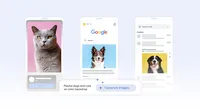Enhance visual storytelling in Demand Gen with generative AI

Demand Gen campaigns were introduced last year to help advertisers create and convert new demand with visual storytelling on Google’s most immersive and entertainment-focused touchpoints — YouTube, YouTube Shorts, Discover, and Gmail. And now, Google is empowering brands and agencies with more tools to tell a compelling and engaging story in a fast-paced, non-linear digital landscape.
Starting today, generative image tools in Demand Gen will be rolling out to advertisers around the world in English with more languages to come later this year. Powered by Google AI, these tools create stunning, high-quality image assets in just a few steps using prompts provided by you. And, if you have existing images that perform well, you can generate similar options with the new “Generate more like this” feature.
Multiply your creative impact in seconds
With generative image tools, you can now test new creative concepts more efficiently — whether it’s experimenting with new types of images or simply building your creatives from scratch. Your knowledge and expertise are crucial to help Google AI generate images tailored to your business or client's needs.
For example, if you have an outdoor lifestyle brand that sells camping gear, use prompts like “vibrantly colored tents illuminated under the Aurora Borealis” to create images that will appeal to those who are shopping for camping trips to Iceland.
Demand Gen will now allow you to provide text prompts to generate more image assets based on your preferences.
Of course, you’ll remain in full control to decide which suggested images will be added to your campaigns. Google is committed to upholding our principles for developing generative AI technology responsibly for fairness, privacy and security. On top of making sure advertising content adheres to our long-standing Google Ads policies, we also employ additional technical measures to ensure generative image tools in Google Ads produce novel and unique content. Google AI will never create two identical images. And all images generated by Google Ads include mechanisms that allow them to be identified as generated, such as an open-standard markup that will surface on tools like Google Image Search, as well as a SynthID, which is an imperceptible, digital watermark that is resistant to manipulations of the image, such as screenshots, filters, and compression. Read more about eligibility and safety principles for generated images in Google Ads on our support page.
More resources to help you flex your creative storytelling on YouTube and Google
To keep audiences engaged and deliver results, advertisers need to diversify their creative strategy with multi-format ads. In fact, those who run both video and image ads with Demand Gen campaigns saw 6% more conversions per dollar than those running image-only ads. 1
Here are more tips to help you build the right creatives for Demand Gen campaigns:
- Provide Google AI with the right assets — Follow the rule of three and include at least 3 images and videos in each aspect ratio (vertical, square and landscape) to maximize reach across all available inventory. Prioritize assets that feel native to each format. For example, when creating YouTube Shorts, prioritize vertical video that’s relatable, authentic and connects with your audience.
- Use high-quality, relevant visuals — Use high-quality, high-resolution videos and images to build brand trust and inspire customer action. If you’re a retailer, product feeds can tailor your ads based on customers’ interest. Upload aspirational short text and images to your Merchant Center feeds to drive deeper consideration. On average, advertisers see 33% more conversions at a similar cost per action (CPA) by adding product feeds to Demand Gen campaigns. 2
- Evaluate and optimize performance — Adopt a test-and-learn strategy as you fine-tune creatives for your unique audiences and goals. Review asset reports to make informed decisions about creative optimization.
To learn more about building the right creatives for Demand Gen, read our latest creative excellence guide. For more general guidance on audiences, bidding and campaign setup, check out our best practices guide.
And be sure to tune into Google Marketing Live 2024 to hear more exciting product updates. Register now for the virtual livestream on May 21, 2024 at 9 a.m. PT, and learn how you can put Google AI to work for your business.






